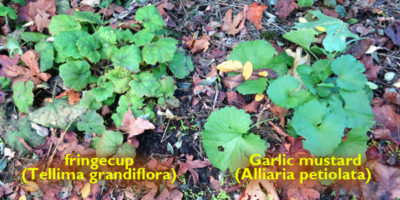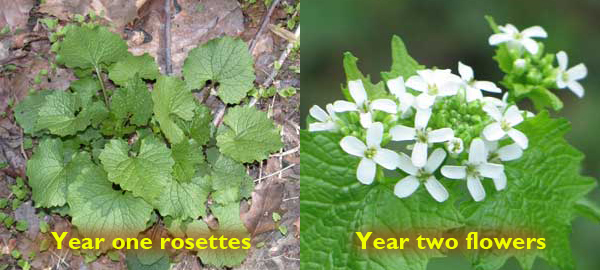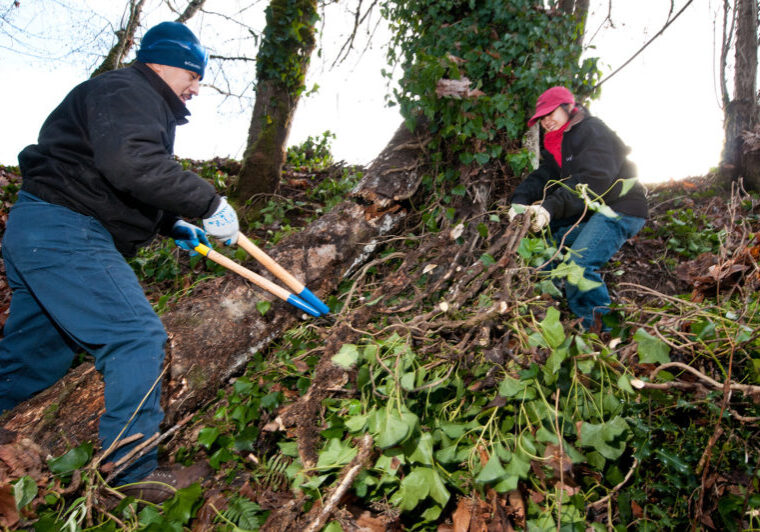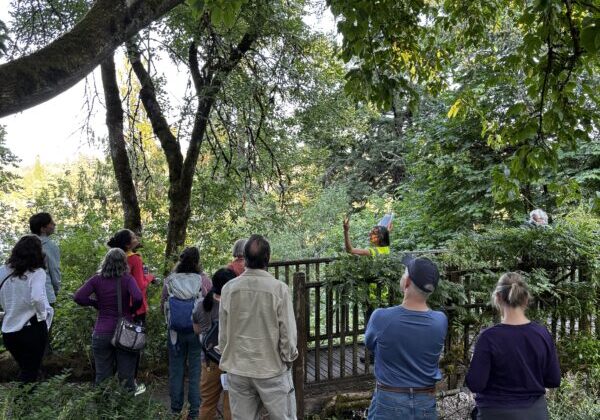Conservation staff are already hard at work on this season’s invasive weed field work. Garlic mustard is at the top of our list again this year for special attention.
Garlic mustard (Alliaria petiolata) is an aggressive invasive species in the Pacific Northwest. Originally introduced in North America for culinary uses, it has escaped cultivation to become a very serious invader in many states. Garlic mustard is a groundcover that can grow in established forests, wetlands, disturbed soil, and people’s yards.
Garlic mustard has few known locations in the Pacific Northwest and urgent action is needed to prevent it from gaining a foothold. The key to controlling garlic mustard is to attack infestations early in spring before the plants have a chance to go to seed.
Garlic mustard is a priority for control because it quickly invades shaded woodland habitats, displacing other plants by monopolizing light, moisture, nutrients, soil, and space. Once established, it also hinders natural forest regeneration by releasing chemicals into the soil that are toxic to other plants and are particularly harmful to soil fungi that are vital to native plants. That makes the woods less hospitable to our native plants and dramatically decreases forage for native animals. This noxious weed impacts sensitive natural areas as well as suburban landscapes, and all known populations in our district are targeted for removal.
We offer free assistance to help manage this invasive plant before it becomes established and too difficult to contain. And we are asking local residents – important stewards of the land – to help us locate and manage this invasive plant by allowing us to come to your property to remove or kill all known infestations. Without immediate attention, this noxious weed will become a very serious threat to our native ecosystems.
Are you able to identify Garlic mustard?
Garlic mustard is a biennial plant with two different forms in its first and second years. The first year it forms a small rosette of round, kidney-shaped leaves, with scalloped edges. In the second year, an elongated flower stalk appears (growing 12- 48 inches) with alternating leaves along the stem. These leaves are different from the first year growth in that they are toothed with a triangular shape. Plants have long, flowering stems with several white flowers. Each flower has 4 white petals in a cross shape. When crushed between the fingers, the plant gives off a distinct garlic smell, distinguishing it from look-alikes. Garlic mustard stems and leaves lack the tiny hairs of similar looking native plants.
Look-alikes

Garlic mustard resembles a number of native plants, including wild ginger (Asarum caudatum), the piggy-back plant (Tolmiea menziesii), and fringecup (Tellima grandiflora). It also looks like the ‘money plant’ (Lunaria annua) or ‘creeping Charlie’ (Glechoma hederacea) when it’s young. Make sure to check for the garlicky smell, smooth stems, and the white flower to confirm garlic mustard.
When to Remove
The most important consideration when dealing with garlic mustard is to prevent flowering plants from going to seed. Hand-pull plants that have bolted and stop before the seed pods harden. Handling garlic mustard when seed pods are opening will scatter seeds; avoid pulling at this stage. First year growth will generally not produce seed and may be removed any time the soil is moist. Second year growth must be removed by late April or May.
Making Progress
This year, District staff and contractors have found an astonishingly small amount of garlic mustard at sites that have been managed for several years. The seed in the soil remains viable for 10-12 years, so it’s possible we are finally extinguishing the seed bank. Even sites that had large infestations last year have small amount this year. It’s also possible that other factors like our cool spring are at play. Still, District staff are optimistic that our collective efforts, including those of our partners, are finally making a significant difference on the landscape!
Our garlic mustard efforts, and those of our partners across the Portland Metro area, are supported by an Oregon State Weed Board grant from Oregon Department of Agriculture and Oregon Watershedwatershed an area of land that channels rainfall, snowmelt, and runoff into a common body of water, such as a nearby lake or river. Multiple streams can be part of the same watershed area, such as the Tryon Creek Watershed which is fed by Oak Creek, Park Creek, Falling Creek, and others. Enhancement Board.
Contact us for help
Contact Michelle Delepine, Invasive Species Program Coordinator, at michelle@wmswcd.org to get started on treatment.



